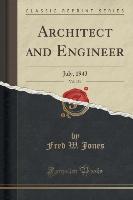Architect and Engineer, Vol. 154
BücherAngebote / Angebote:
Excerpt from Architect and Engineer, Vol. 154: July, 1943
There seems to be a great deal of misunderstanding of the meaning of prefabrication, and, until it is defined and thoroughly understood, a clear picture of the part it is to play in the next few decades will be difficult to develop.
Intrinsic or fundamental prefabrication is not new. In fact, it is probably as old as the ax or the saw and dates from the first purchase of a piece of worked structural wood that a man took home to use in place of the piece he would otherwise have to work up himself. From the beginning of building we have been employing the principal of prefabrication until today a very large proportion of all our structures are prefabricated.
Our doors and windows, many floors, furniture, fixtures and even the bricks in our walls are all prefabricated. So, the question is not whether a house is prefabricated or not, but how much of it is? We might say "my house has prefabricated windows, doors, partitions and roof, but the rest was done on the job." A strictly prefabricated house would be one in which everything was prefabricated but the foundations and, probably, in-so-far as is practical, that is what we are coming to.
And why not? What is wrong with the system? We started out having every timber made by hand, every element of the structure, and have grown to ordering our mill work, fixtures and furniture made elsewhere.
As time goes on the amount and variety of these will increase with the only limit established by practicability and individual taste.
There are many advantages to be reaped from this expansion of the field and extent of prefabrication, not the least of which is the elimination of non-uniform workmanship on the part of individual craftsmen. Quality will undoubtedly become more and more the hall-mark of those prefabricators who stay in business and if they prove their superiority we may yet see a small but entirely prefabricated house set on a prepared foundation.
Perhaps our Joseph Hudnut, Dean of the Harvard School of Design, is right in saying that the future world will pursue its thought "in halls unshadowed by majestic towers, " that, "Great Tudor, Colonial and Etalianate homes will be used only as refuges for superannuated policemen." Mebbe so, mebbe so, but I do not believe that the end of this war, or the next, that we claim is not to come, will usher in a time when there will be no big shots who must have great homes - not if I know my merchant princes.
We are taught that we should be good not for the hope of reward but because it is the right thing to do. By the same token I suppose we should do right not for the purpose of avoiding punishment. Never-the-less many people work hard for mere applause and pay rent to avoid eviction. So, we may be excused for indulging in a few pleasant speculations on possible post war rewards.
Of course, we are fighting this war for freedom and we shall win it and the liberation of mankind, but when the inescapable rewards are passed out we may be permitted a slight chuckle when post war construction materials eliminate certain union labor, such as the plumber and his assistant, when plastic pipes and other bathroom accessories have been introduced.
For those who find no solace in the repeated predictions of the architects who see a rosy future of the possibilities in foreign countries. Perhaps the added feature of a bit of travel may be all that is needed to perk up their imaginations.
Foremost of the countries who need and lack the services of architects and engineers is China. The Chinese not only need new structures to replace those destroyed by war but they are an ancient people developing for them, a new civilization. They are quick to recognize improvements
Folgt in ca. 5 Arbeitstagen


